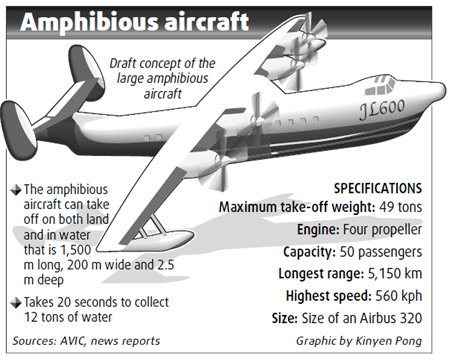
|
CHINA> National
 |
|
Water aircraft lands in 2013
By Xin Dingding (China Daily)
Updated: 2009-10-20 09:11 The first Chinese-made large amphibious aircraft is scheduled to take off in 2013, and ready for mass production in 2015, a senior engineer for the manufacturer said. The amphibious aircraft, about the size of an Airbus 320, will handle emergency services and military tasks that are difficult or impossible with current aircraft in China today.  Previously, China has developed large hydroplanes and small amphibious aircraft, said Chen Zhengguo, the project's chief engineer.
The Chinese-made amphibious aircraft can take off on both land and water. "It is especially useful in extinguishing wildfires, as it needs only 20 seconds to collect 12 tons of water," said Chen, who is also deputy chief engineer with the China Special Vehicle Research Institute under AVIC. As it flies at a height of 30 to 50 m over the treetops, the success rate of spreading water over a fire could reach 98 percent. According to the State Forestry Administration, at least 10,000 wildfires occur in the country's forests each year. An official said under condition of anonymity that since the Sichuan earthquake last May, the government has rented two large helicopters from Russia for emergencies like forest fires. Each of these large helicopters can carry 15 tons of water, but the cost is also expensive - 60 million yuan a year. "If the large amphibious aircraft is completed, it could be a cheaper but still efficient option," he said. Engineers also aimed to develop the amphibious aircraft into one that can help rescue more people on the sea. Equipped with turboprop engines, it has a maximum take-off weight of 49 tons, able to carry up to 50 people at one time. Its longest range is 5,150 km, and its highest speed is 560 kph. Emergency medical equipment will be available on board. But as accidents often occur in bad weather on the sea, the engineers aim to make the amphibious aircraft able to take off in waters with waves up to three m, "which will be a challenge," he said. Countries including Russia, Japan, Canada and the United States already have developed their own amphibious aircraft. "We will develop the large amphibious aircraft on our own, but we are considering cooperation with Russia in fields such as engines and airborne systems to make the aircraft achieve a more reliable performance," Chen said. |